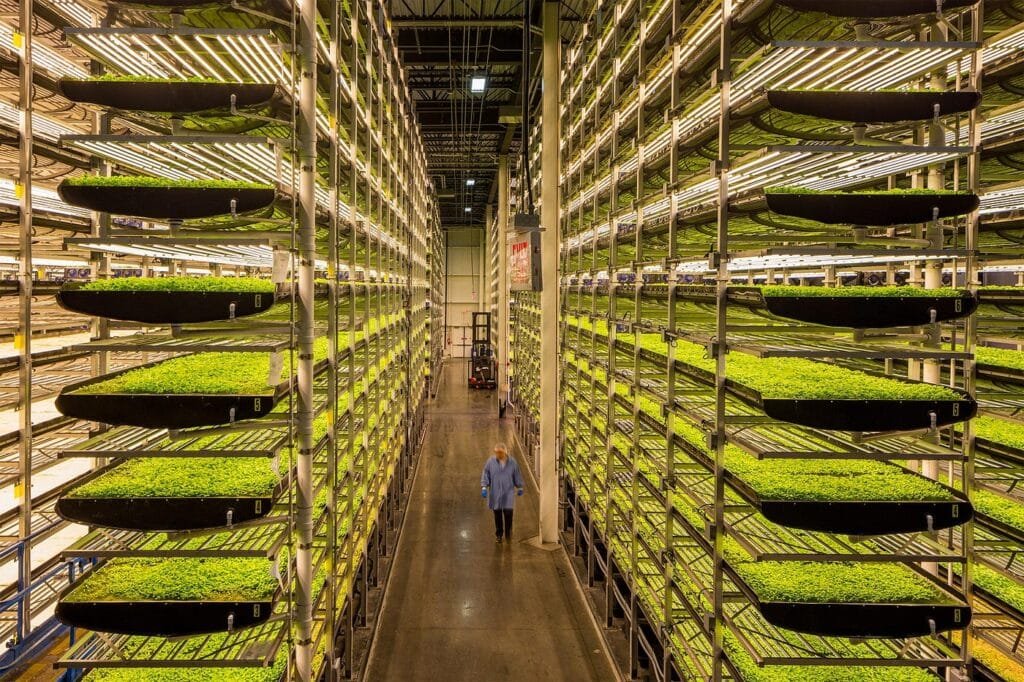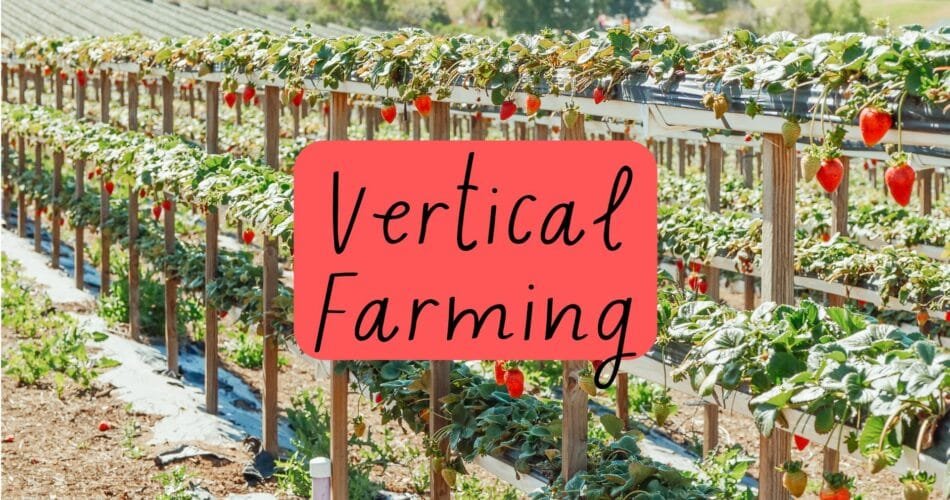This blog contains Information about Vertical Farming. In the start, it defines and introduces Vertical Farming in detail. Then it explains the Benefits of Vertical Farming. It also elaborates the Technologies driving Vertical Farming. Then it discusses the Challenges of Vertical Farming. It also provide some examples of Vertical Farming practicing Around the World. In the end, it explains the Economic Viability and Future Trends of Vertical Farming. This blog contains Technologies and Benefits of Vertical Farming.
Introduction to Vertical Farming:
Vertical farming is an innovative agricultural practice that involves growing crops in vertically stacked layers, often utilizing controlled environment agriculture (CEA) techniques.
This method diverges significantly from traditional farming, which typically relies on expansive land areas and natural growing conditions. Vertical farms can be housed in urban environments, repurposing existing buildings such as warehouses and factories, thereby addressing space limitations increasingly experienced due to urbanization.
The concept of vertical farming can be traced back to the early 20th century, but it has only become mainstream in recent years. Methods such as hydroponics, aeroponics, and aquaponics are often incorporated in vertical farming systems, which allow for efficient resource use, reducing the need for soil while minimizing water consumption compared to conventional agriculture. This is particularly relevant in the context of climate change, where traditional farming is continuously challenged by unpredictable weather patterns and dwindling arable land.
As the global population expands, there arises a concomitant need for sustainable food production methods. Vertical farming offers a solution by enabling the local production of food, thus minimizing transportation costs and reducing carbon footprints. Furthermore, with urban areas projected to house more than two-thirds of the world’s population by 2050, the adoption of vertical farming techniques is likely to continue rising. This farming approach not only meets the demand for fresh produce but also promotes food security by decoupling food production from the limitations of geography.
In sum, vertical farming presents an adaptive response to contemporary agricultural challenges, emphasizing efficiency, sustainability, and urban integration in food production systems. As innovation persists in this arena, vertical farming may play a pivotal role in reshaping the future of agriculture. This blog contains Technologies and Benefits of Vertical Farming.
The Benefits of Vertical Farming:
Vertical farming presents a transformative approach to agriculture that systematically addresses critical challenges faced by traditional farming methods. The benefits of Vertical Farming are as follows:
. Sustainability:
One of the most significant advantages of vertical farming is its sustainability. By utilizing controlled environments, vertical farms can produce food all year round, irrespective of weather conditions or seasonal constraints. This capability maximizes agricultural output while minimizing the carbon footprint associated with transporting food over long distances.
. Space Efficiency:
Another notable benefit is space efficiency. Unlike conventional farming, which requires expansive land areas, vertical farming optimizes the use of vertical space by stacking multiple layers of crops. This method is particularly advantageous in urban settings where available land is often limited. As cities continue to grow, vertical farms offer a viable solution for urban dwellers to access fresh produce without the need for extensive land use.
. Reduce Water Usage:
In terms of sustainability, vertical farming significantly reduces water usage compared to traditional agriculture. Through techniques such as hydroponics and aeroponics, water is recirculated within the systems, leading to a reduction in overall water consumption by up to 90%. This aspect is crucial in mitigating the water scarcity challenges that many regions face today.
. Health Benefits:
The health benefits associated with vertically farmed produce are also noteworthy. By eliminating or significantly reducing the reliance on pesticides, vertical farming promotes the cultivation of healthier, chemical-free fruits and vegetables. Furthermore, because these crops are grown closer to the consumer, they can be harvested and delivered at optimal freshness, thereby preserving their nutritional value. The ability to grow a diverse array of crops in urban centers not only enhances food security but also encourages healthier eating habits among city residents.
These are some of the benefits of Vertical Farming.

Technologies Driving Vertical Farming:
Vertical farming has emerged as a revolutionary approach to agriculture, leveraging innovative technologies to cultivate crops in a controlled environment. Central to this movement are methods such as hydroponics and aeroponics, which significantly optimize resource use and improve yield potential.
Hydroponics:
Hydroponics involves growing plants in nutrient-rich water solutions, eliminating the need for soil and allowing for precise control over nutrient availability. This method not only accelerates growth rates but also reduces the amount of water used compared to traditional farming practices.
Aeroponics:
Aeroponics takes this a step further by suspending plants in a mist environment. Providing them with nutrients and moisture directly to their root systems. This soil-less cultivation technique enables plants to thrive with minimal water and space. That makes it an ideal choice for high-density farming systems. Both hydroponics and aeroponics minimize the risks associated with soil-borne diseases, leading to healthier crops and reduced pesticide usage.
LED Lighting:
In addition to these growing methods, the integration of LED lighting plays a crucial role in vertical farming. LEDs are energy-efficient light sources that can be adjusted to emit specific wavelengths, thereby optimizing photosynthesis for various plant species. With the capability to simulate natural sunlight and extend growing hours, LED lighting enhances crop productivity while keeping energy consumption low. This emphasis on controlled growing environments ensures that crops can be produced year-round, independent of external weather conditions.
Collectively, these technologies—hydroponics, aeroponics, and LED lighting—forge a sustainable pathway for future food production. They not only maximize crop yields but also align with environmentally friendly practices, reducing the agricultural footprint. As vertical farming continues to develop, these technologies will be instrumental in addressing the pressing challenges of food insecurity and climate change. This blog contains Technologies and Benefits of Vertical Farming.
Challenges Faced in Vertical Farming:
Vertical farming, while promising a sustainable solution for food production, is not without its challenges and limitations. These challenges are as follows:
1. High Initial Investment:
One of the primary hurdles is the high initial investment costs associated with setting up a vertical farm. These costs can include purchasing specialized equipment, integrating advanced technologies, and ensuring a suitable environment for crop growth. While the operational costs may vary based on location and scale. Potential investors often face a steep barrier due to the significant upfront financial commitment required.
2. Energy Consumption:
Energy consumption is another critical concern in vertical farming systems. These farms rely heavily on artificial lighting and climate control to create optimal growing conditions, which can lead to substantial electricity use. Consequently, this reliance on energy may negate some of the environmental benefits that vertical farming aims to deliver. It is essential for operators to explore renewable energy solutions or efficient power management systems to mitigate the environmental impact of energy consumption.
3. Technological Expertise:
Furthermore, vertical farming requires a distinct level of technical expertise that can pose challenges for those entering the field. Understanding hydroponics, aeroponics, and the necessary monitoring systems for climate control, nutrient delivery, and pest management is crucial. Any deficiency in knowledge can lead to crop failures or reduced yields, underscoring the need for comprehensive training and education in this innovative agricultural approach.
4. Controlled Environments:
Lastly, the controlled environments of vertical farms can, paradoxically, create conditions conducive to crop diseases and pest infestations. While traditional agriculture benefits from natural predators and seasonal changes, vertical farms may require advanced pest management strategies and rigorous sanitation protocols to prevent outbreaks.
Addressing these challenges is vital for the successful implementation and long-term viability of vertical farming as a sustainable agricultural solution. This blog contains Technologies and Benefits of Vertical Farming.
Vertical Farming Around the World:
Vertical farming has emerged as a transformative solution in sustainable agriculture, with various successful initiatives taking root across the globe. Countries are harnessing innovative methods to implement vertical agriculture systems that address urbanization, food security, and environmental challenges. One notable case is Aero-Farms in the United States, where aeroponic technology is used to grow leafy greens without soil. This method reduces water usage by 95% compared to traditional farming and allows for year-round crop production, contributing to local food systems.
Vertical Farming in Singapore:
In Singapore, a nation with limited arable land, vertical farming has become integral to enhancing food sovereignty. Sky Greens operates a pioneering vertical farm that employs an innovative rotating system to maximize sunlight exposure and water efficiency. Their installations have showcased the potential of urban agriculture to supply fresh produce directly to the city’s markets. By minimizing transportation costs and emissions.
Vertical Farming in Netherlands:
Another exemplary initiative can be found in the Netherlands, home to companies like Plant Lab. They use controlled environments combined with automated systems to cultivate a variety of crops. The Dutch approach to vertical farming emphasizes energy efficiency through partnerships with renewable energy providers and the strategic use of greenhouse technologies. This synergy has led to impressive yield increases while reducing the carbon footprint associated with conventional agriculture.
Vertical Farming in Asia:
Across Asia, farms such as the Spread Company in Japan have integrated robotics and artificial intelligence into vertical farming practices. Their facilities monitor and optimize growth conditions continuously, enabling large-scale production of vegetables like lettuce with minimal human intervention. This incorporation of technology highlights the adaptability of vertical farming techniques to varied operational contexts.
Ultimately, these global examples underscore the versatility and potential of vertical farming. By illustrating how localized solutions can effectively address unique agricultural challenges while advancing towards a more sustainable future.
Economic Viability of Vertical Farming:
The economic viability of vertical farming presents a plethora of opportunities and challenges that merit a detailed examination. As urban populations continue to grow, the demand for locally grown produce has surged, leading to an increased interest in vertical farming systems. This method of agriculture not only maximizes land use. But also minimizes transportation costs and carbon emissions associated with food logistics.
Initial Cost:
A cost-benefit analysis reveals that while initial setup costs can be high—due to the technology and infrastructure needed. For indoor farming—operational costs may decrease over time through resource efficiency and yields per square foot that often surpass traditional farming practices.
Profitability of Vertical Farming:
In terms of profitability, vertical farms can capitalize on the premium prices associated with organic and locally sourced produce. Consumer awareness regarding sustainability and the carbon footprint of food products supports a favorable market for these goods. Furthermore, by employing hydroponic and aeroponic systems, vertical farms can grow crops year-round, undeniably enhancing their economic prospects by providing a steady supply of produce regardless of climatic conditions.
Investment for Vertical Farming:
Funding sources for vertical farming initiatives can be diverse. Investments may come from private investors, venture capitalists, or governmental grants aimed at promoting sustainable agricultural practices. As the technology surrounding vertical farming continues to advance, forward-thinking investors are beginning to recognize its potential as a viable business model. It is imperative for entrepreneurs in this sector to develop comprehensive business plans that detail market analysis, defined consumer segments, and strategic distribution channels to effectively address the rising demand.
In conclusion, while the initial barriers to entry can be considerable, the combination of increasing consumer demand for local, sustainable produce along with innovative advancements in agricultural technology positions vertical farming as a promising and economically viable alternative in the agricultural landscape. This blog contains Technologies and Benefits of Vertical Farming.
Future Trends in Vertical Farming
The vertical farming industry is poised to undergo significant transformations in the coming years, driven by advancements in technology and changes in consumer preferences. As urban populations continue to rise, the demand for locally-produced, fresh food is becoming increasingly critical. This shift is propelling the development of innovative farming techniques and operational efficiencies that vertical farming can uniquely offer.
Automation Technology:
One of the most notable trends is the rise of automated systems in vertical farms. Automation technology, including artificial intelligence, robotics, and sensors, is revolutionizing the cultivation process. These advancements allow for precise monitoring of plant health, optimal growth conditions, and resource management. Thereby reducing labor costs and enhancing yield efficiency. For instance, automated climate control systems regulate light, temperature, and humidity, ensuring that crops grow under ideal conditions year-round. This technology not only conserves resources but also improves overall productivity.
Climate Resilient Food Supply Chain:
Additionally, climate change poses new challenges to food production, making vertical farming an increasingly attractive solution. Given its ability to bypass traditional environmental constraints, such as arable land availability and adverse weather conditions. Vertical farming will likely provide more resilient food supply chains. The potential to produce food using less water and reducing reliance on pesticides enhances the sustainability profile of this farming method.
Fresh Food for Urban Populations:
Moreover, consumer preferences are shifting towards sustainability, organic practices, and transparency in food sourcing. As consumers become more conscious of their environmental impact, the demand for locally sourced and organically grown produce continues to surge. Vertical farms, with their capacity to provide fresh produce in urban areas, align well with these evolving consumer values. As such, the future of vertical farming looks promising, with innovations constantly emerging to meet the challenges of modern agriculture while catering to a more eco-conscious consumer base. This blog contains Technologies and benefits of Vertical Farming.
Vertical Farming and Food Security
Vertical farming represents a significant innovation in modern agriculture, particularly in terms of enhancing food security in urban environments. As the global population continues to swell, urban areas are increasingly becoming the epicenters of population density. While leading to multifaceted challenges associated with food supply chains. Vertical farming addresses these challenges by allowing food production to take place closer to consumers. With effectively reducing transportation costs and emissions. This also work for mitigating the risks associated with supply chain disruptions.
Controlled Environment Agricultural Technique:
In densely populated regions, vertical farms can help ensure consistent and reliable access to fresh produce. These farms utilize controlled environment agriculture (CEA) techniques, enabling crops to be grown year-round, irrespective of external weather conditions. This capability is particularly crucial in urban settings where traditional farming practices are often impractical due to limited space and environmental factors. By producing food within city limits, vertical farms can contribute to lowering food prices and ensuring that communities have access to nutritious options, thus addressing hunger and food insecurity.
Hydroponics and Aeroponics:
Moreover, vertical farming promotes sustainable agricultural practices. By implementing hydroponics or aeroponics, these farms use significantly less water compared to conventional farming methods. This creates an essential resource during times of drought or water scarcity. Furthermore, the vertical farming model typically does not rely on pesticides, resulting in healthier food and a lesser environmental footprint. The ability to grow food locally also supports economic resilience within communities, bringing jobs and fostering innovation in agriculture and urban planning.
By integrating technology and sustainability, vertical farming offers promising solutions to enhance food security challenges in urban areas. As cities continue to evolve, adopting and investing in such innovative agricultural models, It will be crucial for ensuring that growing populations have equitable access to reliable and fresh food sources. This blog contains Technologies and Benefits of Vertical Farming.
Conclusion: The Future of Agriculture
Vertical farming represents a transformative approach to modern agriculture, possessing the potential to significantly enhance food production efficiency while minimizing environmental impact. As urbanization rises and the global population expands, the challenges associated with traditional farming methods have become more pronounced. Vertical farming offers innovative solutions to these challenges by utilizing less land and providing year-round crop production. All while reducing the need for pesticides and minimizing water usage.
Future advancements in technology, such as increased automation and improved energy efficiency. It will further bolster the capabilities of vertical farms, making them an even more appealing option. Continuous research and investment in this agricultural method are vital as they will help address the various challenges that arise, from energy consumption to crop diversity. Collaborative efforts among governments, private sectors, and research institutions are essential in developing best practices. And regulatory frameworks that support the growth of vertical farming.
As we move forward, it is imperative that stakeholders foster an environment conducive to innovation and experimentation within vertical farming. This collective commitment will not only enhance the viability of vertical farming as a sustainable food source. But also ensure that agriculture can meet the demands of an ever-growing population while preserving precious environmental resources. Embracing vertical farming will indeed play a crucial role in shaping the future landscape of agriculture and food security worldwide. This blog contains Technologies and Benefits of Vertical Farming.

To learn about more Topics, Click the link below:


Comments